Analysis of Vulnerabilities in Data as a Service (DaaS) Cloud Offering
VerifiedAdded on 2023/01/05
|46
|18221
|26
Thesis and Dissertation
AI Summary
This dissertation examines the vulnerabilities associated with Data as a Service (DaaS) cloud offerings, particularly within the context of higher education. The study begins with an introduction to cloud computing and DaaS, emphasizing their importance and benefits. It then delves into a literature review, exploring different cloud computing services, the use of DaaS in higher education, and the challenges and vulnerabilities inherent in DaaS cloud offerings. The research methodology outlines the approach taken, including data collection and analysis techniques. The findings, discussed in detail, highlight the security issues and vulnerabilities associated with DaaS in higher education. Finally, the dissertation concludes with recommendations for mitigating these vulnerabilities and promoting the effective and secure use of DaaS in educational settings. The study aims to analyze and recommend ways in which vulnerabilities associated with Cloud offering of Data as a Service can be reduced and can be effectively used in higher education. This research utilizes secondary data analysis and thematic data analysis methods.

DISSERTATION
Paraphrase This Document
Need a fresh take? Get an instant paraphrase of this document with our AI Paraphraser
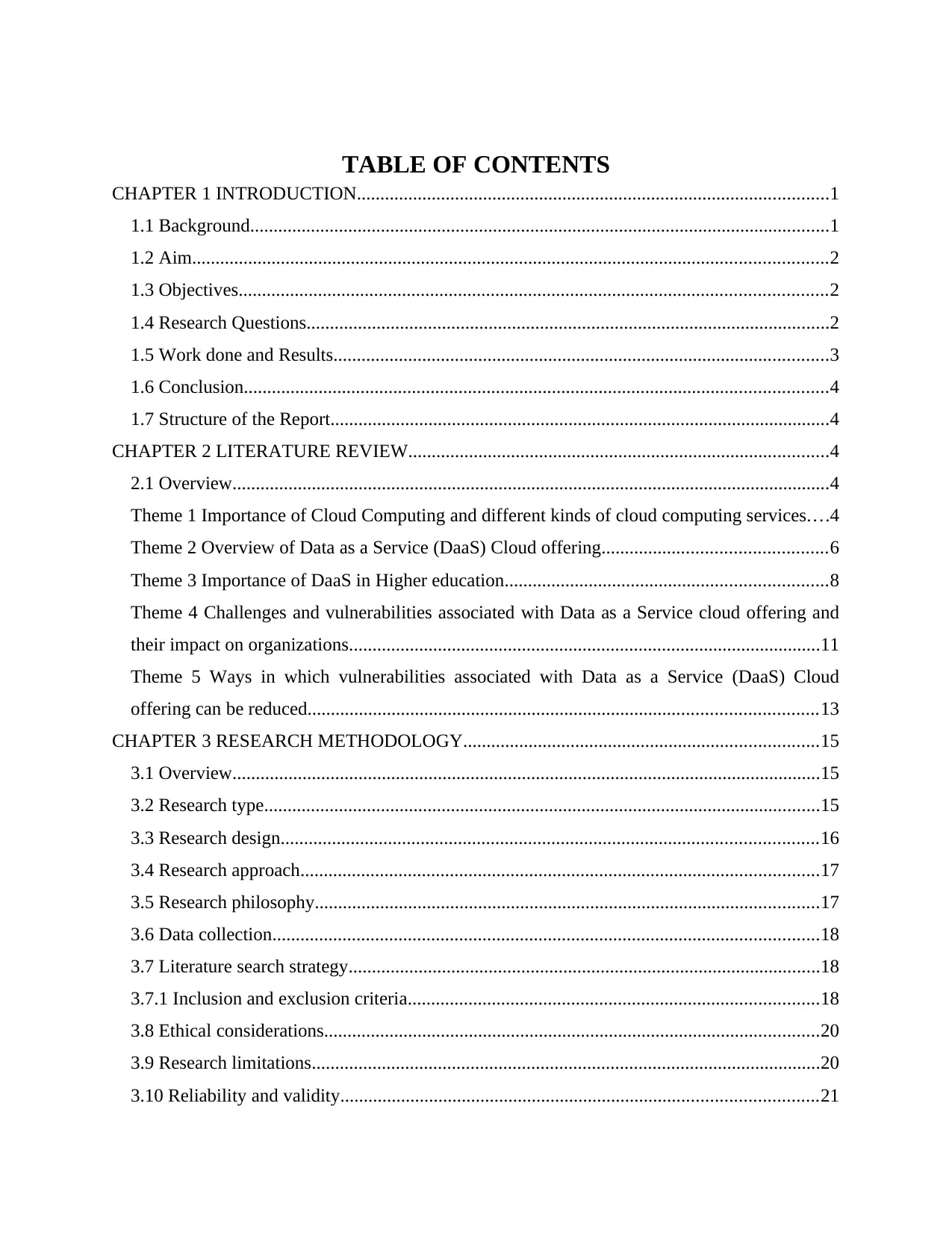
TABLE OF CONTENTS
CHAPTER 1 INTRODUCTION.....................................................................................................1
1.1 Background............................................................................................................................1
1.2 Aim........................................................................................................................................2
1.3 Objectives..............................................................................................................................2
1.4 Research Questions................................................................................................................2
1.5 Work done and Results..........................................................................................................3
1.6 Conclusion.............................................................................................................................4
1.7 Structure of the Report...........................................................................................................4
CHAPTER 2 LITERATURE REVIEW..........................................................................................4
2.1 Overview................................................................................................................................4
Theme 1 Importance of Cloud Computing and different kinds of cloud computing services....4
Theme 2 Overview of Data as a Service (DaaS) Cloud offering................................................6
Theme 3 Importance of DaaS in Higher education.....................................................................8
Theme 4 Challenges and vulnerabilities associated with Data as a Service cloud offering and
their impact on organizations.....................................................................................................11
Theme 5 Ways in which vulnerabilities associated with Data as a Service (DaaS) Cloud
offering can be reduced.............................................................................................................13
CHAPTER 3 RESEARCH METHODOLOGY............................................................................15
3.1 Overview..............................................................................................................................15
3.2 Research type.......................................................................................................................15
3.3 Research design...................................................................................................................16
3.4 Research approach...............................................................................................................17
3.5 Research philosophy............................................................................................................17
3.6 Data collection.....................................................................................................................18
3.7 Literature search strategy.....................................................................................................18
3.7.1 Inclusion and exclusion criteria........................................................................................18
3.8 Ethical considerations..........................................................................................................20
3.9 Research limitations.............................................................................................................20
3.10 Reliability and validity......................................................................................................21
CHAPTER 1 INTRODUCTION.....................................................................................................1
1.1 Background............................................................................................................................1
1.2 Aim........................................................................................................................................2
1.3 Objectives..............................................................................................................................2
1.4 Research Questions................................................................................................................2
1.5 Work done and Results..........................................................................................................3
1.6 Conclusion.............................................................................................................................4
1.7 Structure of the Report...........................................................................................................4
CHAPTER 2 LITERATURE REVIEW..........................................................................................4
2.1 Overview................................................................................................................................4
Theme 1 Importance of Cloud Computing and different kinds of cloud computing services....4
Theme 2 Overview of Data as a Service (DaaS) Cloud offering................................................6
Theme 3 Importance of DaaS in Higher education.....................................................................8
Theme 4 Challenges and vulnerabilities associated with Data as a Service cloud offering and
their impact on organizations.....................................................................................................11
Theme 5 Ways in which vulnerabilities associated with Data as a Service (DaaS) Cloud
offering can be reduced.............................................................................................................13
CHAPTER 3 RESEARCH METHODOLOGY............................................................................15
3.1 Overview..............................................................................................................................15
3.2 Research type.......................................................................................................................15
3.3 Research design...................................................................................................................16
3.4 Research approach...............................................................................................................17
3.5 Research philosophy............................................................................................................17
3.6 Data collection.....................................................................................................................18
3.7 Literature search strategy.....................................................................................................18
3.7.1 Inclusion and exclusion criteria........................................................................................18
3.8 Ethical considerations..........................................................................................................20
3.9 Research limitations.............................................................................................................20
3.10 Reliability and validity......................................................................................................21
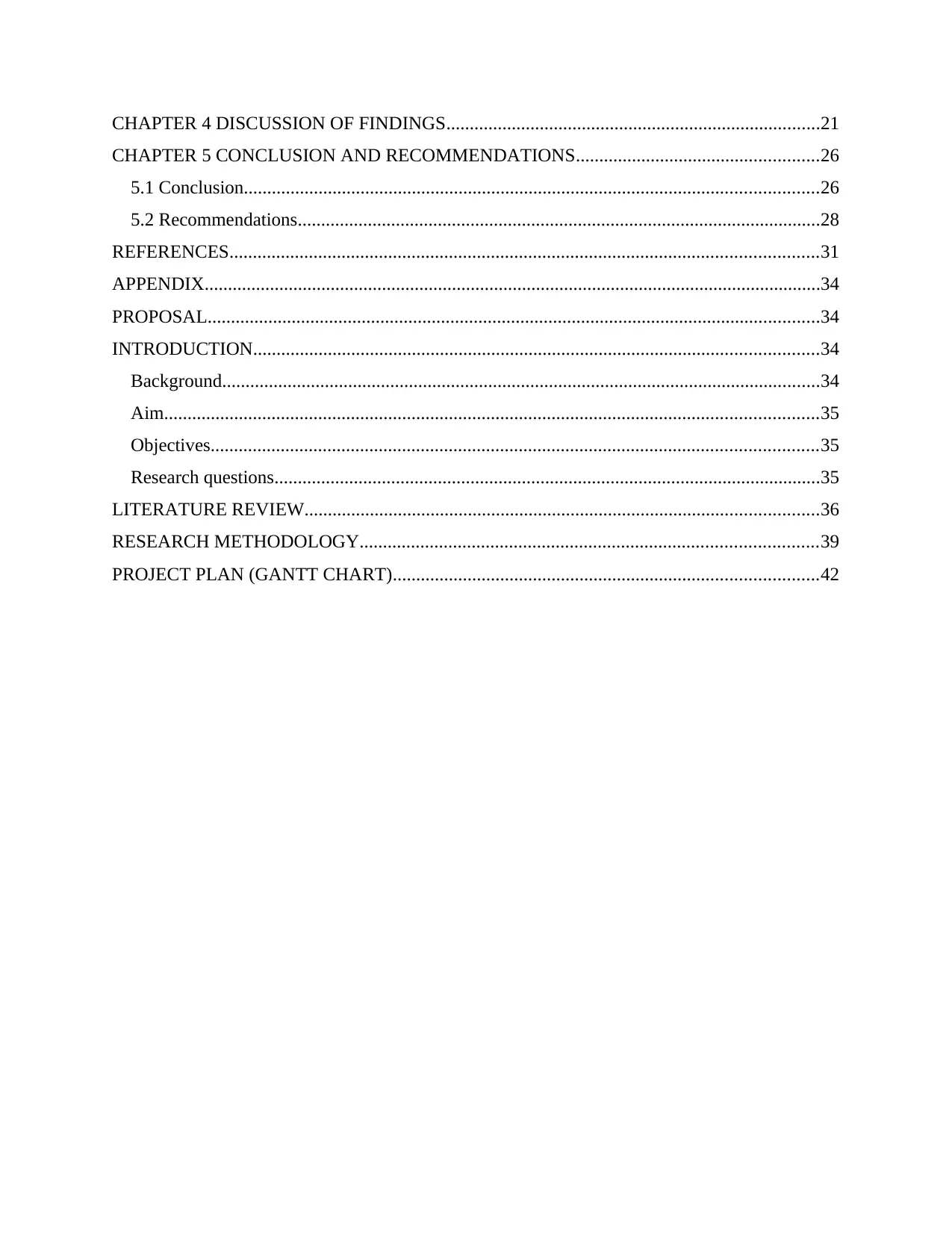
CHAPTER 4 DISCUSSION OF FINDINGS................................................................................21
CHAPTER 5 CONCLUSION AND RECOMMENDATIONS....................................................26
5.1 Conclusion...........................................................................................................................26
5.2 Recommendations................................................................................................................28
REFERENCES..............................................................................................................................31
APPENDIX....................................................................................................................................34
PROPOSAL...................................................................................................................................34
INTRODUCTION.........................................................................................................................34
Background................................................................................................................................34
Aim............................................................................................................................................35
Objectives..................................................................................................................................35
Research questions.....................................................................................................................35
LITERATURE REVIEW..............................................................................................................36
RESEARCH METHODOLOGY..................................................................................................39
PROJECT PLAN (GANTT CHART)...........................................................................................42
CHAPTER 5 CONCLUSION AND RECOMMENDATIONS....................................................26
5.1 Conclusion...........................................................................................................................26
5.2 Recommendations................................................................................................................28
REFERENCES..............................................................................................................................31
APPENDIX....................................................................................................................................34
PROPOSAL...................................................................................................................................34
INTRODUCTION.........................................................................................................................34
Background................................................................................................................................34
Aim............................................................................................................................................35
Objectives..................................................................................................................................35
Research questions.....................................................................................................................35
LITERATURE REVIEW..............................................................................................................36
RESEARCH METHODOLOGY..................................................................................................39
PROJECT PLAN (GANTT CHART)...........................................................................................42
⊘ This is a preview!⊘
Do you want full access?
Subscribe today to unlock all pages.

Trusted by 1+ million students worldwide
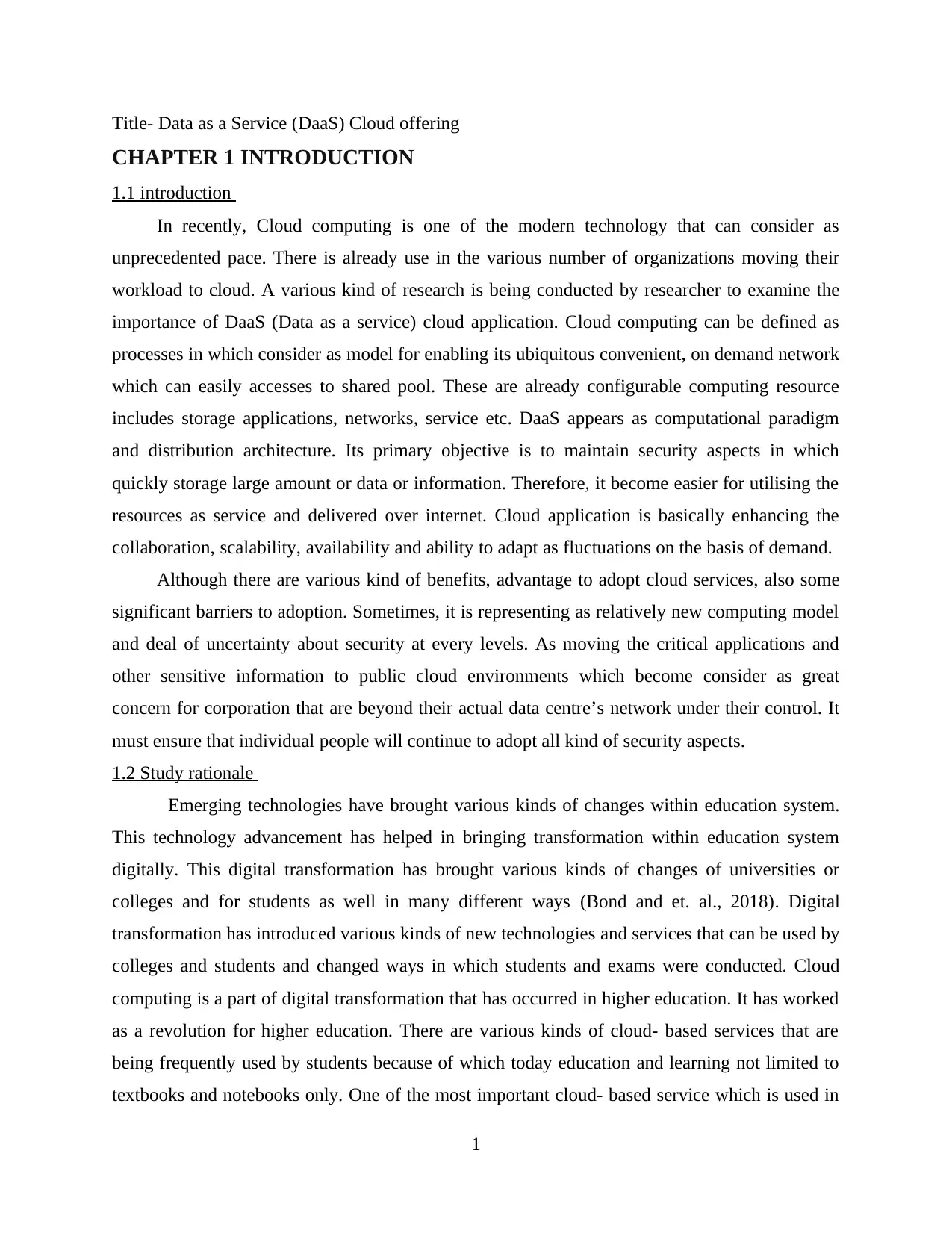
Title- Data as a Service (DaaS) Cloud offering
CHAPTER 1 INTRODUCTION
1.1 introduction
In recently, Cloud computing is one of the modern technology that can consider as
unprecedented pace. There is already use in the various number of organizations moving their
workload to cloud. A various kind of research is being conducted by researcher to examine the
importance of DaaS (Data as a service) cloud application. Cloud computing can be defined as
processes in which consider as model for enabling its ubiquitous convenient, on demand network
which can easily accesses to shared pool. These are already configurable computing resource
includes storage applications, networks, service etc. DaaS appears as computational paradigm
and distribution architecture. Its primary objective is to maintain security aspects in which
quickly storage large amount or data or information. Therefore, it become easier for utilising the
resources as service and delivered over internet. Cloud application is basically enhancing the
collaboration, scalability, availability and ability to adapt as fluctuations on the basis of demand.
Although there are various kind of benefits, advantage to adopt cloud services, also some
significant barriers to adoption. Sometimes, it is representing as relatively new computing model
and deal of uncertainty about security at every levels. As moving the critical applications and
other sensitive information to public cloud environments which become consider as great
concern for corporation that are beyond their actual data centre’s network under their control. It
must ensure that individual people will continue to adopt all kind of security aspects.
1.2 Study rationale
Emerging technologies have brought various kinds of changes within education system.
This technology advancement has helped in bringing transformation within education system
digitally. This digital transformation has brought various kinds of changes of universities or
colleges and for students as well in many different ways (Bond and et. al., 2018). Digital
transformation has introduced various kinds of new technologies and services that can be used by
colleges and students and changed ways in which students and exams were conducted. Cloud
computing is a part of digital transformation that has occurred in higher education. It has worked
as a revolution for higher education. There are various kinds of cloud- based services that are
being frequently used by students because of which today education and learning not limited to
textbooks and notebooks only. One of the most important cloud- based service which is used in
1
CHAPTER 1 INTRODUCTION
1.1 introduction
In recently, Cloud computing is one of the modern technology that can consider as
unprecedented pace. There is already use in the various number of organizations moving their
workload to cloud. A various kind of research is being conducted by researcher to examine the
importance of DaaS (Data as a service) cloud application. Cloud computing can be defined as
processes in which consider as model for enabling its ubiquitous convenient, on demand network
which can easily accesses to shared pool. These are already configurable computing resource
includes storage applications, networks, service etc. DaaS appears as computational paradigm
and distribution architecture. Its primary objective is to maintain security aspects in which
quickly storage large amount or data or information. Therefore, it become easier for utilising the
resources as service and delivered over internet. Cloud application is basically enhancing the
collaboration, scalability, availability and ability to adapt as fluctuations on the basis of demand.
Although there are various kind of benefits, advantage to adopt cloud services, also some
significant barriers to adoption. Sometimes, it is representing as relatively new computing model
and deal of uncertainty about security at every levels. As moving the critical applications and
other sensitive information to public cloud environments which become consider as great
concern for corporation that are beyond their actual data centre’s network under their control. It
must ensure that individual people will continue to adopt all kind of security aspects.
1.2 Study rationale
Emerging technologies have brought various kinds of changes within education system.
This technology advancement has helped in bringing transformation within education system
digitally. This digital transformation has brought various kinds of changes of universities or
colleges and for students as well in many different ways (Bond and et. al., 2018). Digital
transformation has introduced various kinds of new technologies and services that can be used by
colleges and students and changed ways in which students and exams were conducted. Cloud
computing is a part of digital transformation that has occurred in higher education. It has worked
as a revolution for higher education. There are various kinds of cloud- based services that are
being frequently used by students because of which today education and learning not limited to
textbooks and notebooks only. One of the most important cloud- based service which is used in
1
Paraphrase This Document
Need a fresh take? Get an instant paraphrase of this document with our AI Paraphraser
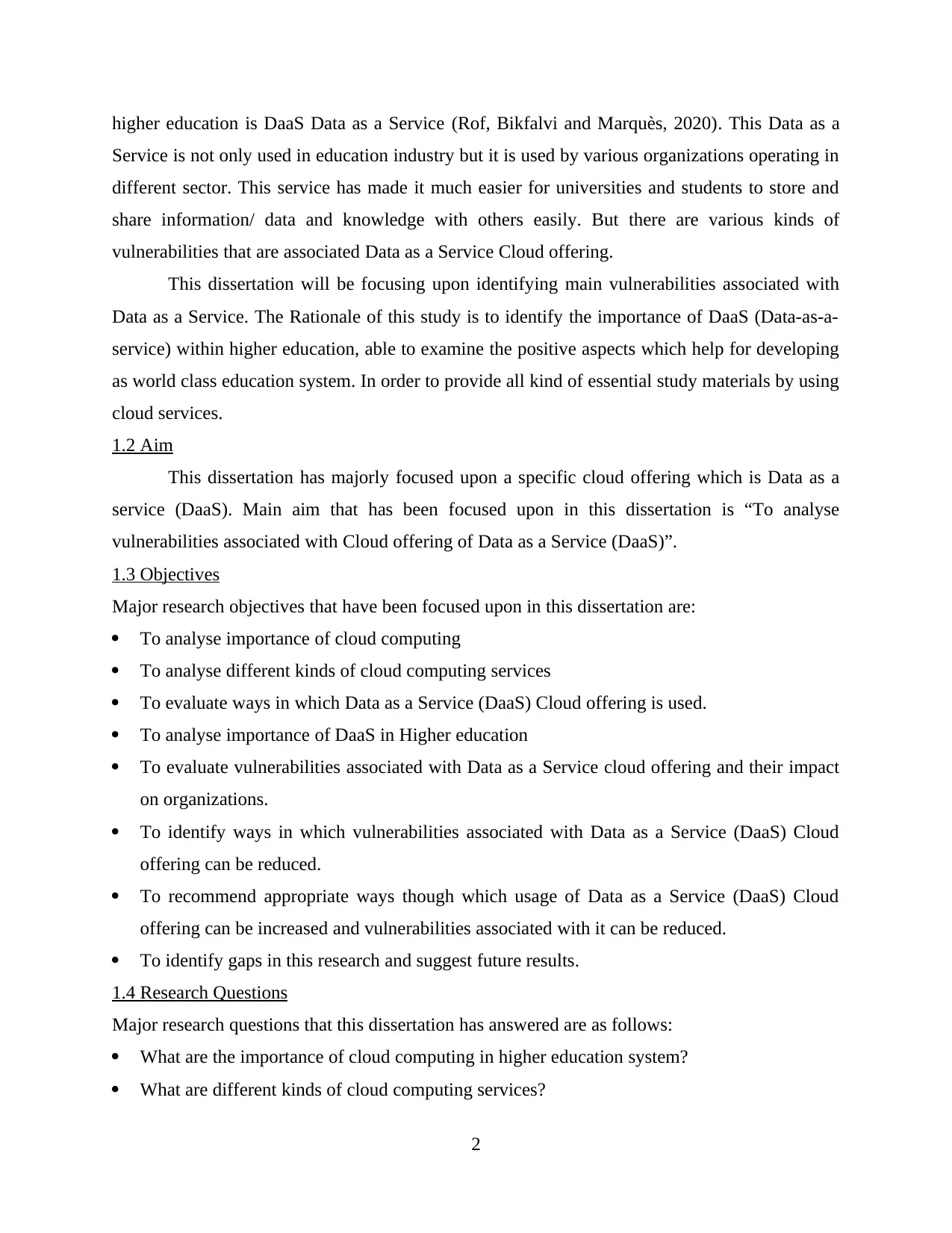
higher education is DaaS Data as a Service (Rof, Bikfalvi and Marquès, 2020). This Data as a
Service is not only used in education industry but it is used by various organizations operating in
different sector. This service has made it much easier for universities and students to store and
share information/ data and knowledge with others easily. But there are various kinds of
vulnerabilities that are associated Data as a Service Cloud offering.
This dissertation will be focusing upon identifying main vulnerabilities associated with
Data as a Service. The Rationale of this study is to identify the importance of DaaS (Data-as-a-
service) within higher education, able to examine the positive aspects which help for developing
as world class education system. In order to provide all kind of essential study materials by using
cloud services.
1.2 Aim
This dissertation has majorly focused upon a specific cloud offering which is Data as a
service (DaaS). Main aim that has been focused upon in this dissertation is “To analyse
vulnerabilities associated with Cloud offering of Data as a Service (DaaS)”.
1.3 Objectives
Major research objectives that have been focused upon in this dissertation are:
To analyse importance of cloud computing
To analyse different kinds of cloud computing services
To evaluate ways in which Data as a Service (DaaS) Cloud offering is used.
To analyse importance of DaaS in Higher education
To evaluate vulnerabilities associated with Data as a Service cloud offering and their impact
on organizations.
To identify ways in which vulnerabilities associated with Data as a Service (DaaS) Cloud
offering can be reduced.
To recommend appropriate ways though which usage of Data as a Service (DaaS) Cloud
offering can be increased and vulnerabilities associated with it can be reduced.
To identify gaps in this research and suggest future results.
1.4 Research Questions
Major research questions that this dissertation has answered are as follows:
What are the importance of cloud computing in higher education system?
What are different kinds of cloud computing services?
2
Service is not only used in education industry but it is used by various organizations operating in
different sector. This service has made it much easier for universities and students to store and
share information/ data and knowledge with others easily. But there are various kinds of
vulnerabilities that are associated Data as a Service Cloud offering.
This dissertation will be focusing upon identifying main vulnerabilities associated with
Data as a Service. The Rationale of this study is to identify the importance of DaaS (Data-as-a-
service) within higher education, able to examine the positive aspects which help for developing
as world class education system. In order to provide all kind of essential study materials by using
cloud services.
1.2 Aim
This dissertation has majorly focused upon a specific cloud offering which is Data as a
service (DaaS). Main aim that has been focused upon in this dissertation is “To analyse
vulnerabilities associated with Cloud offering of Data as a Service (DaaS)”.
1.3 Objectives
Major research objectives that have been focused upon in this dissertation are:
To analyse importance of cloud computing
To analyse different kinds of cloud computing services
To evaluate ways in which Data as a Service (DaaS) Cloud offering is used.
To analyse importance of DaaS in Higher education
To evaluate vulnerabilities associated with Data as a Service cloud offering and their impact
on organizations.
To identify ways in which vulnerabilities associated with Data as a Service (DaaS) Cloud
offering can be reduced.
To recommend appropriate ways though which usage of Data as a Service (DaaS) Cloud
offering can be increased and vulnerabilities associated with it can be reduced.
To identify gaps in this research and suggest future results.
1.4 Research Questions
Major research questions that this dissertation has answered are as follows:
What are the importance of cloud computing in higher education system?
What are different kinds of cloud computing services?
2

How could identify the facilities offers by Data as a Service (DaaS)?
What are various kind of vulnerabilities associated with Data as a Service cloud offering and
impact on organizations?
What are different ways in which vulnerabilities associated with Data as a Service (DaaS)
Cloud offering can be reduced?
What are suggested advice that can help to reduce the vulnerabilities in the cloud computing
(Data as a Service (DaaS) Cloud?
1.5 Work done and Results
In this research secondary data analysis has been done for successfully achieving main
aim and objectives. In this dissertation importance of digital transformation in higher education
has been discussed. Ways in which new and advance digital technology in higher education is
being used and transforming higher education has also been discussed briefly. Then, in this
dissertation a brief overview of importance of cloud computing and different kinds of services
offered by cloud services providers has been discussed.
All the secondary data has been collected from different sources though articles,
journals, books, online portals and many more and using appropriate literature search strategy
data was collected. It help for researcher to get more detailed information regarding DaaS as
cloud service. Sometimes, it acquire all essential information through secondary analysis.
Different articles, books and journals have been given brief idea about the research topic or
subject. The most important thing is that when secondary analysis support to collect, store large
information but needs to be filtered accordingly. Through this way, it can gain more insight view
of research study while identifying relevant information or data. That’s why, it can support for
further doing research analysis. Sometimes, pre-existing theories and other relevant materials
have been included in the data collection, storage. In order to identify vulnerabilities associated
with Cloud offering of Data as a Service using exploratory research design method required data
has been collected and analysed using thematic data analysis method.
Results of this dissertation has further been used to identify and recommend ways in
which vulnerabilities associated with Cloud offering of Data as a Service can be reduced and can
be effectively used in higher education. Moreover, vulnerabilities, threats are associated with
cloud computing at the time of service. Therefore, it should need to collect more information or
data in which help to further generating accurate result or outcome.
3
What are various kind of vulnerabilities associated with Data as a Service cloud offering and
impact on organizations?
What are different ways in which vulnerabilities associated with Data as a Service (DaaS)
Cloud offering can be reduced?
What are suggested advice that can help to reduce the vulnerabilities in the cloud computing
(Data as a Service (DaaS) Cloud?
1.5 Work done and Results
In this research secondary data analysis has been done for successfully achieving main
aim and objectives. In this dissertation importance of digital transformation in higher education
has been discussed. Ways in which new and advance digital technology in higher education is
being used and transforming higher education has also been discussed briefly. Then, in this
dissertation a brief overview of importance of cloud computing and different kinds of services
offered by cloud services providers has been discussed.
All the secondary data has been collected from different sources though articles,
journals, books, online portals and many more and using appropriate literature search strategy
data was collected. It help for researcher to get more detailed information regarding DaaS as
cloud service. Sometimes, it acquire all essential information through secondary analysis.
Different articles, books and journals have been given brief idea about the research topic or
subject. The most important thing is that when secondary analysis support to collect, store large
information but needs to be filtered accordingly. Through this way, it can gain more insight view
of research study while identifying relevant information or data. That’s why, it can support for
further doing research analysis. Sometimes, pre-existing theories and other relevant materials
have been included in the data collection, storage. In order to identify vulnerabilities associated
with Cloud offering of Data as a Service using exploratory research design method required data
has been collected and analysed using thematic data analysis method.
Results of this dissertation has further been used to identify and recommend ways in
which vulnerabilities associated with Cloud offering of Data as a Service can be reduced and can
be effectively used in higher education. Moreover, vulnerabilities, threats are associated with
cloud computing at the time of service. Therefore, it should need to collect more information or
data in which help to further generating accurate result or outcome.
3
⊘ This is a preview!⊘
Do you want full access?
Subscribe today to unlock all pages.

Trusted by 1+ million students worldwide
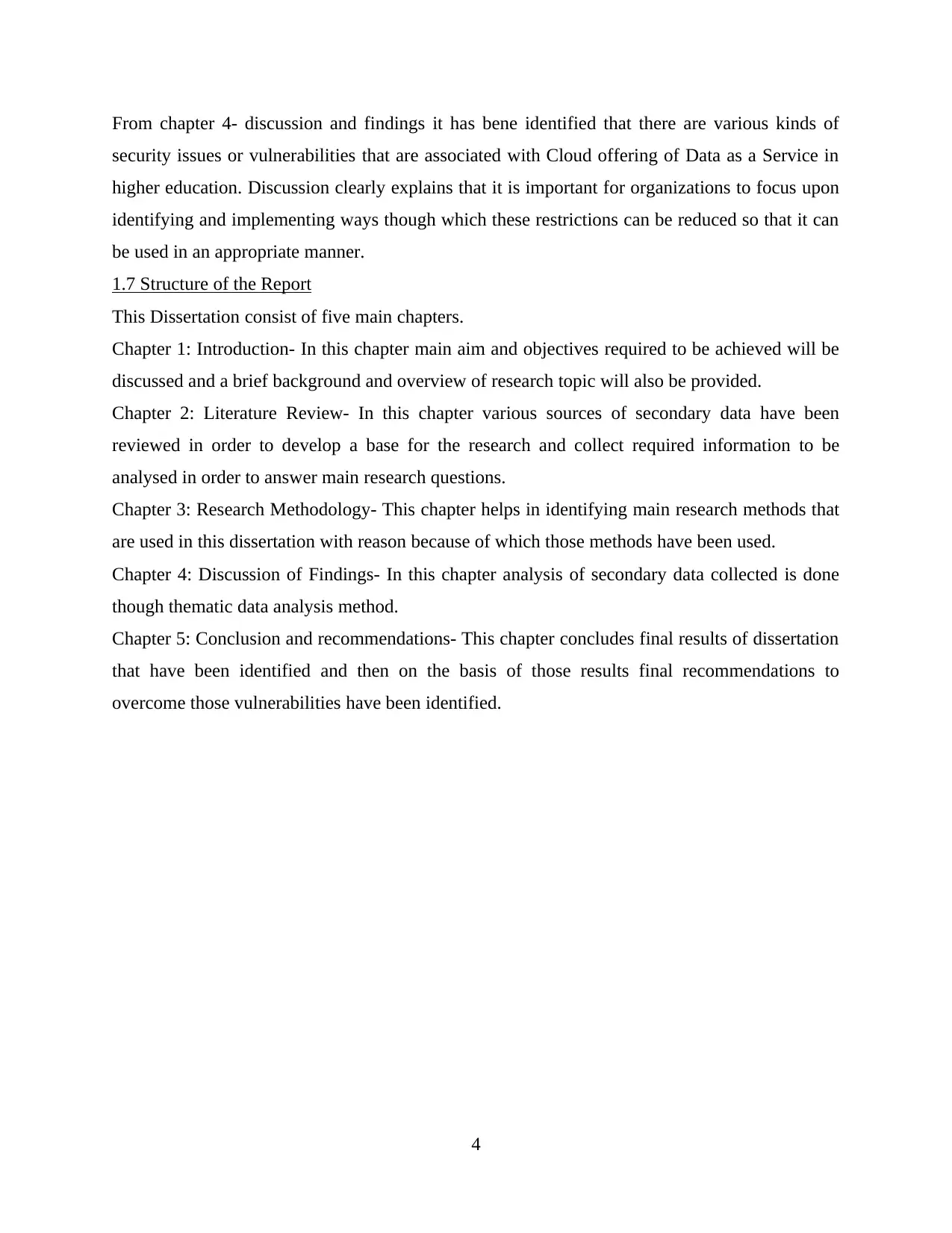
From chapter 4- discussion and findings it has bene identified that there are various kinds of
security issues or vulnerabilities that are associated with Cloud offering of Data as a Service in
higher education. Discussion clearly explains that it is important for organizations to focus upon
identifying and implementing ways though which these restrictions can be reduced so that it can
be used in an appropriate manner.
1.7 Structure of the Report
This Dissertation consist of five main chapters.
Chapter 1: Introduction- In this chapter main aim and objectives required to be achieved will be
discussed and a brief background and overview of research topic will also be provided.
Chapter 2: Literature Review- In this chapter various sources of secondary data have been
reviewed in order to develop a base for the research and collect required information to be
analysed in order to answer main research questions.
Chapter 3: Research Methodology- This chapter helps in identifying main research methods that
are used in this dissertation with reason because of which those methods have been used.
Chapter 4: Discussion of Findings- In this chapter analysis of secondary data collected is done
though thematic data analysis method.
Chapter 5: Conclusion and recommendations- This chapter concludes final results of dissertation
that have been identified and then on the basis of those results final recommendations to
overcome those vulnerabilities have been identified.
4
security issues or vulnerabilities that are associated with Cloud offering of Data as a Service in
higher education. Discussion clearly explains that it is important for organizations to focus upon
identifying and implementing ways though which these restrictions can be reduced so that it can
be used in an appropriate manner.
1.7 Structure of the Report
This Dissertation consist of five main chapters.
Chapter 1: Introduction- In this chapter main aim and objectives required to be achieved will be
discussed and a brief background and overview of research topic will also be provided.
Chapter 2: Literature Review- In this chapter various sources of secondary data have been
reviewed in order to develop a base for the research and collect required information to be
analysed in order to answer main research questions.
Chapter 3: Research Methodology- This chapter helps in identifying main research methods that
are used in this dissertation with reason because of which those methods have been used.
Chapter 4: Discussion of Findings- In this chapter analysis of secondary data collected is done
though thematic data analysis method.
Chapter 5: Conclusion and recommendations- This chapter concludes final results of dissertation
that have been identified and then on the basis of those results final recommendations to
overcome those vulnerabilities have been identified.
4
Paraphrase This Document
Need a fresh take? Get an instant paraphrase of this document with our AI Paraphraser
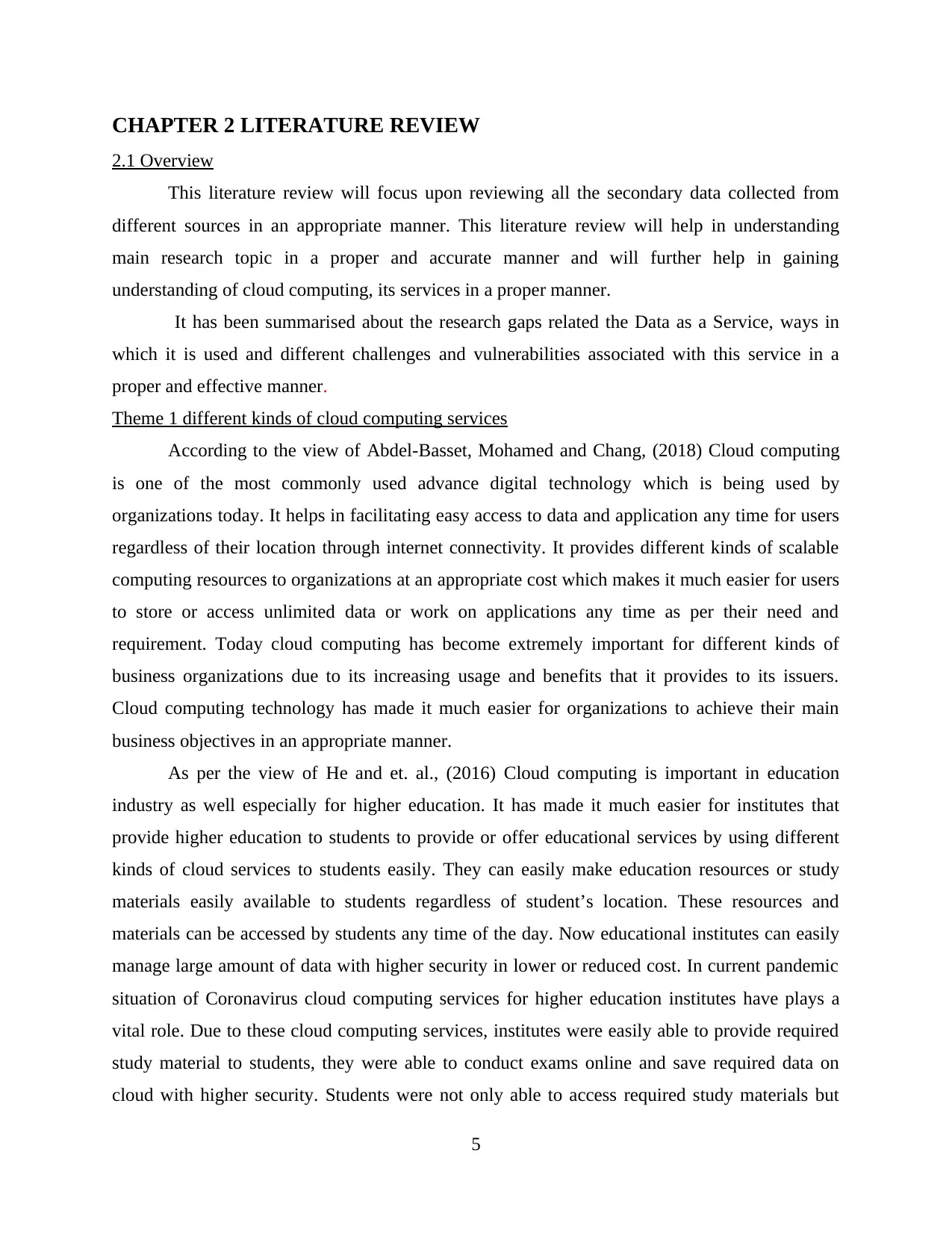
CHAPTER 2 LITERATURE REVIEW
2.1 Overview
This literature review will focus upon reviewing all the secondary data collected from
different sources in an appropriate manner. This literature review will help in understanding
main research topic in a proper and accurate manner and will further help in gaining
understanding of cloud computing, its services in a proper manner.
It has been summarised about the research gaps related the Data as a Service, ways in
which it is used and different challenges and vulnerabilities associated with this service in a
proper and effective manner.
Theme 1 different kinds of cloud computing services
According to the view of Abdel-Basset, Mohamed and Chang, (2018) Cloud computing
is one of the most commonly used advance digital technology which is being used by
organizations today. It helps in facilitating easy access to data and application any time for users
regardless of their location through internet connectivity. It provides different kinds of scalable
computing resources to organizations at an appropriate cost which makes it much easier for users
to store or access unlimited data or work on applications any time as per their need and
requirement. Today cloud computing has become extremely important for different kinds of
business organizations due to its increasing usage and benefits that it provides to its issuers.
Cloud computing technology has made it much easier for organizations to achieve their main
business objectives in an appropriate manner.
As per the view of He and et. al., (2016) Cloud computing is important in education
industry as well especially for higher education. It has made it much easier for institutes that
provide higher education to students to provide or offer educational services by using different
kinds of cloud services to students easily. They can easily make education resources or study
materials easily available to students regardless of student’s location. These resources and
materials can be accessed by students any time of the day. Now educational institutes can easily
manage large amount of data with higher security in lower or reduced cost. In current pandemic
situation of Coronavirus cloud computing services for higher education institutes have plays a
vital role. Due to these cloud computing services, institutes were easily able to provide required
study material to students, they were able to conduct exams online and save required data on
cloud with higher security. Students were not only able to access required study materials but
5
2.1 Overview
This literature review will focus upon reviewing all the secondary data collected from
different sources in an appropriate manner. This literature review will help in understanding
main research topic in a proper and accurate manner and will further help in gaining
understanding of cloud computing, its services in a proper manner.
It has been summarised about the research gaps related the Data as a Service, ways in
which it is used and different challenges and vulnerabilities associated with this service in a
proper and effective manner.
Theme 1 different kinds of cloud computing services
According to the view of Abdel-Basset, Mohamed and Chang, (2018) Cloud computing
is one of the most commonly used advance digital technology which is being used by
organizations today. It helps in facilitating easy access to data and application any time for users
regardless of their location through internet connectivity. It provides different kinds of scalable
computing resources to organizations at an appropriate cost which makes it much easier for users
to store or access unlimited data or work on applications any time as per their need and
requirement. Today cloud computing has become extremely important for different kinds of
business organizations due to its increasing usage and benefits that it provides to its issuers.
Cloud computing technology has made it much easier for organizations to achieve their main
business objectives in an appropriate manner.
As per the view of He and et. al., (2016) Cloud computing is important in education
industry as well especially for higher education. It has made it much easier for institutes that
provide higher education to students to provide or offer educational services by using different
kinds of cloud services to students easily. They can easily make education resources or study
materials easily available to students regardless of student’s location. These resources and
materials can be accessed by students any time of the day. Now educational institutes can easily
manage large amount of data with higher security in lower or reduced cost. In current pandemic
situation of Coronavirus cloud computing services for higher education institutes have plays a
vital role. Due to these cloud computing services, institutes were easily able to provide required
study material to students, they were able to conduct exams online and save required data on
cloud with higher security. Students were not only able to access required study materials but
5
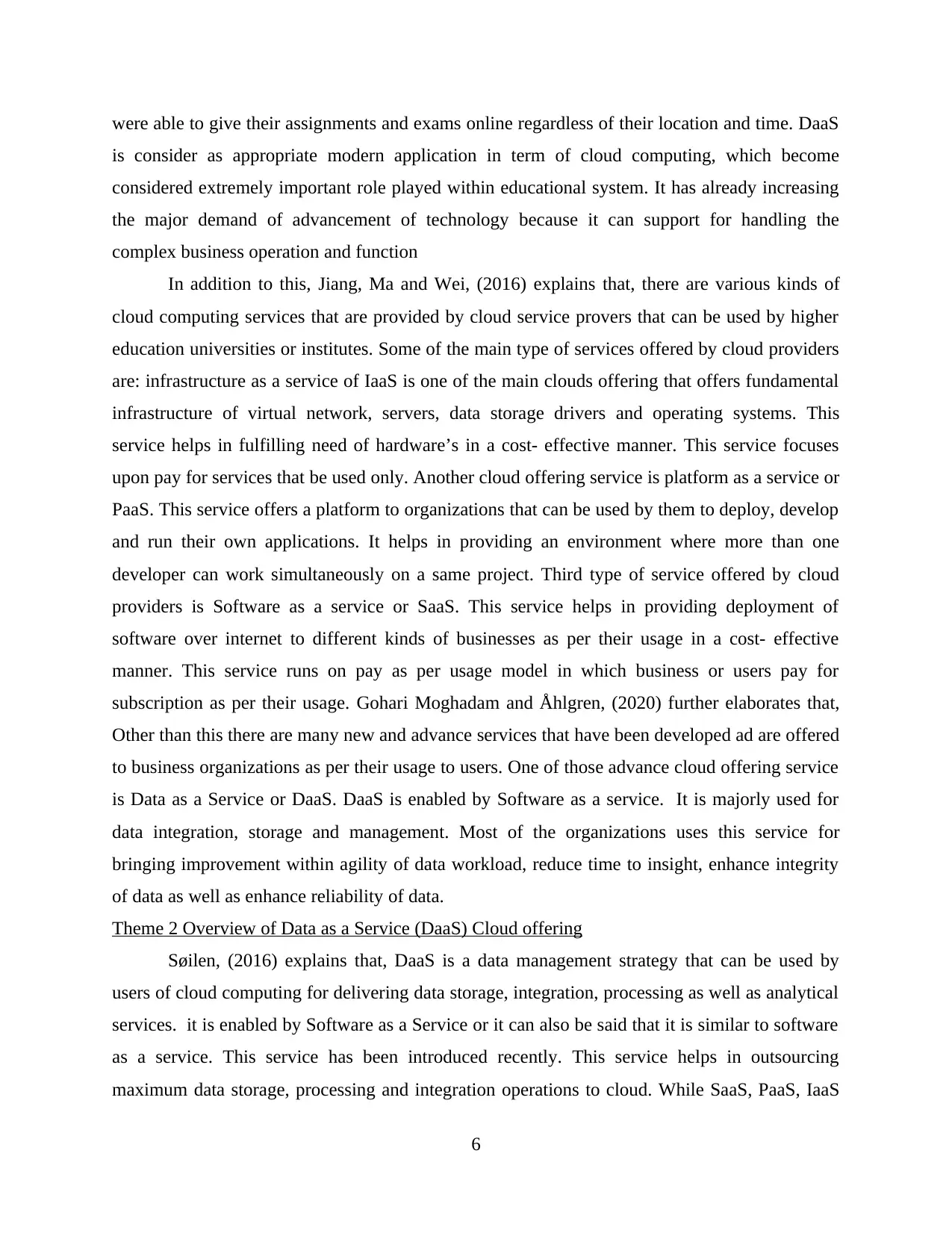
were able to give their assignments and exams online regardless of their location and time. DaaS
is consider as appropriate modern application in term of cloud computing, which become
considered extremely important role played within educational system. It has already increasing
the major demand of advancement of technology because it can support for handling the
complex business operation and function
In addition to this, Jiang, Ma and Wei, (2016) explains that, there are various kinds of
cloud computing services that are provided by cloud service provers that can be used by higher
education universities or institutes. Some of the main type of services offered by cloud providers
are: infrastructure as a service of IaaS is one of the main clouds offering that offers fundamental
infrastructure of virtual network, servers, data storage drivers and operating systems. This
service helps in fulfilling need of hardware’s in a cost- effective manner. This service focuses
upon pay for services that be used only. Another cloud offering service is platform as a service or
PaaS. This service offers a platform to organizations that can be used by them to deploy, develop
and run their own applications. It helps in providing an environment where more than one
developer can work simultaneously on a same project. Third type of service offered by cloud
providers is Software as a service or SaaS. This service helps in providing deployment of
software over internet to different kinds of businesses as per their usage in a cost- effective
manner. This service runs on pay as per usage model in which business or users pay for
subscription as per their usage. Gohari Moghadam and Åhlgren, (2020) further elaborates that,
Other than this there are many new and advance services that have been developed ad are offered
to business organizations as per their usage to users. One of those advance cloud offering service
is Data as a Service or DaaS. DaaS is enabled by Software as a service. It is majorly used for
data integration, storage and management. Most of the organizations uses this service for
bringing improvement within agility of data workload, reduce time to insight, enhance integrity
of data as well as enhance reliability of data.
Theme 2 Overview of Data as a Service (DaaS) Cloud offering
Søilen, (2016) explains that, DaaS is a data management strategy that can be used by
users of cloud computing for delivering data storage, integration, processing as well as analytical
services. it is enabled by Software as a Service or it can also be said that it is similar to software
as a service. This service has been introduced recently. This service helps in outsourcing
maximum data storage, processing and integration operations to cloud. While SaaS, PaaS, IaaS
6
is consider as appropriate modern application in term of cloud computing, which become
considered extremely important role played within educational system. It has already increasing
the major demand of advancement of technology because it can support for handling the
complex business operation and function
In addition to this, Jiang, Ma and Wei, (2016) explains that, there are various kinds of
cloud computing services that are provided by cloud service provers that can be used by higher
education universities or institutes. Some of the main type of services offered by cloud providers
are: infrastructure as a service of IaaS is one of the main clouds offering that offers fundamental
infrastructure of virtual network, servers, data storage drivers and operating systems. This
service helps in fulfilling need of hardware’s in a cost- effective manner. This service focuses
upon pay for services that be used only. Another cloud offering service is platform as a service or
PaaS. This service offers a platform to organizations that can be used by them to deploy, develop
and run their own applications. It helps in providing an environment where more than one
developer can work simultaneously on a same project. Third type of service offered by cloud
providers is Software as a service or SaaS. This service helps in providing deployment of
software over internet to different kinds of businesses as per their usage in a cost- effective
manner. This service runs on pay as per usage model in which business or users pay for
subscription as per their usage. Gohari Moghadam and Åhlgren, (2020) further elaborates that,
Other than this there are many new and advance services that have been developed ad are offered
to business organizations as per their usage to users. One of those advance cloud offering service
is Data as a Service or DaaS. DaaS is enabled by Software as a service. It is majorly used for
data integration, storage and management. Most of the organizations uses this service for
bringing improvement within agility of data workload, reduce time to insight, enhance integrity
of data as well as enhance reliability of data.
Theme 2 Overview of Data as a Service (DaaS) Cloud offering
Søilen, (2016) explains that, DaaS is a data management strategy that can be used by
users of cloud computing for delivering data storage, integration, processing as well as analytical
services. it is enabled by Software as a Service or it can also be said that it is similar to software
as a service. This service has been introduced recently. This service helps in outsourcing
maximum data storage, processing and integration operations to cloud. While SaaS, PaaS, IaaS
6
⊘ This is a preview!⊘
Do you want full access?
Subscribe today to unlock all pages.

Trusted by 1+ million students worldwide
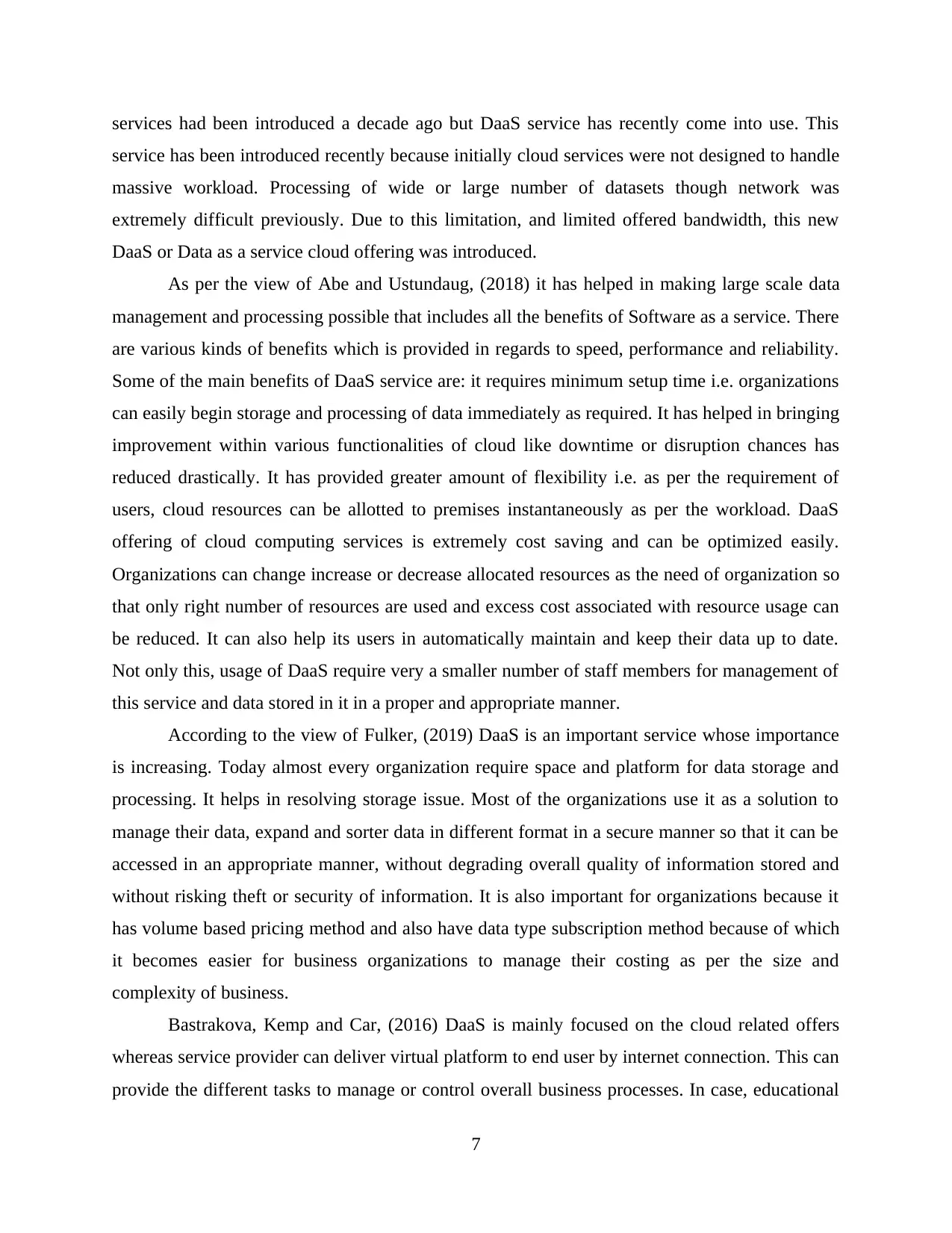
services had been introduced a decade ago but DaaS service has recently come into use. This
service has been introduced recently because initially cloud services were not designed to handle
massive workload. Processing of wide or large number of datasets though network was
extremely difficult previously. Due to this limitation, and limited offered bandwidth, this new
DaaS or Data as a service cloud offering was introduced.
As per the view of Abe and Ustundaug, (2018) it has helped in making large scale data
management and processing possible that includes all the benefits of Software as a service. There
are various kinds of benefits which is provided in regards to speed, performance and reliability.
Some of the main benefits of DaaS service are: it requires minimum setup time i.e. organizations
can easily begin storage and processing of data immediately as required. It has helped in bringing
improvement within various functionalities of cloud like downtime or disruption chances has
reduced drastically. It has provided greater amount of flexibility i.e. as per the requirement of
users, cloud resources can be allotted to premises instantaneously as per the workload. DaaS
offering of cloud computing services is extremely cost saving and can be optimized easily.
Organizations can change increase or decrease allocated resources as the need of organization so
that only right number of resources are used and excess cost associated with resource usage can
be reduced. It can also help its users in automatically maintain and keep their data up to date.
Not only this, usage of DaaS require very a smaller number of staff members for management of
this service and data stored in it in a proper and appropriate manner.
According to the view of Fulker, (2019) DaaS is an important service whose importance
is increasing. Today almost every organization require space and platform for data storage and
processing. It helps in resolving storage issue. Most of the organizations use it as a solution to
manage their data, expand and sorter data in different format in a secure manner so that it can be
accessed in an appropriate manner, without degrading overall quality of information stored and
without risking theft or security of information. It is also important for organizations because it
has volume based pricing method and also have data type subscription method because of which
it becomes easier for business organizations to manage their costing as per the size and
complexity of business.
Bastrakova, Kemp and Car, (2016) DaaS is mainly focused on the cloud related offers
whereas service provider can deliver virtual platform to end user by internet connection. This can
provide the different tasks to manage or control overall business processes. In case, educational
7
service has been introduced recently because initially cloud services were not designed to handle
massive workload. Processing of wide or large number of datasets though network was
extremely difficult previously. Due to this limitation, and limited offered bandwidth, this new
DaaS or Data as a service cloud offering was introduced.
As per the view of Abe and Ustundaug, (2018) it has helped in making large scale data
management and processing possible that includes all the benefits of Software as a service. There
are various kinds of benefits which is provided in regards to speed, performance and reliability.
Some of the main benefits of DaaS service are: it requires minimum setup time i.e. organizations
can easily begin storage and processing of data immediately as required. It has helped in bringing
improvement within various functionalities of cloud like downtime or disruption chances has
reduced drastically. It has provided greater amount of flexibility i.e. as per the requirement of
users, cloud resources can be allotted to premises instantaneously as per the workload. DaaS
offering of cloud computing services is extremely cost saving and can be optimized easily.
Organizations can change increase or decrease allocated resources as the need of organization so
that only right number of resources are used and excess cost associated with resource usage can
be reduced. It can also help its users in automatically maintain and keep their data up to date.
Not only this, usage of DaaS require very a smaller number of staff members for management of
this service and data stored in it in a proper and appropriate manner.
According to the view of Fulker, (2019) DaaS is an important service whose importance
is increasing. Today almost every organization require space and platform for data storage and
processing. It helps in resolving storage issue. Most of the organizations use it as a solution to
manage their data, expand and sorter data in different format in a secure manner so that it can be
accessed in an appropriate manner, without degrading overall quality of information stored and
without risking theft or security of information. It is also important for organizations because it
has volume based pricing method and also have data type subscription method because of which
it becomes easier for business organizations to manage their costing as per the size and
complexity of business.
Bastrakova, Kemp and Car, (2016) DaaS is mainly focused on the cloud related offers
whereas service provider can deliver virtual platform to end user by internet connection. This can
provide the different tasks to manage or control overall business processes. In case, educational
7
Paraphrase This Document
Need a fresh take? Get an instant paraphrase of this document with our AI Paraphraser
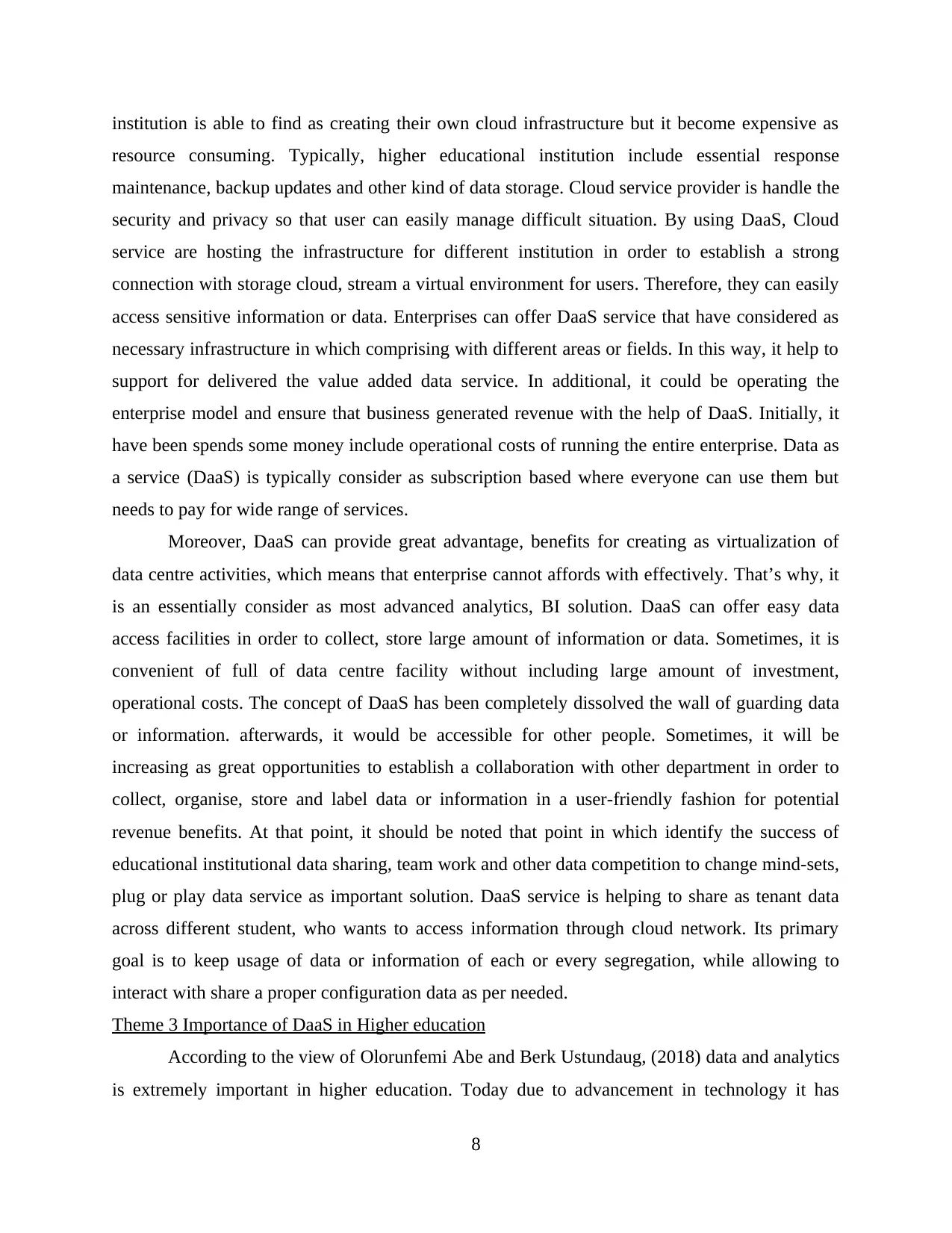
institution is able to find as creating their own cloud infrastructure but it become expensive as
resource consuming. Typically, higher educational institution include essential response
maintenance, backup updates and other kind of data storage. Cloud service provider is handle the
security and privacy so that user can easily manage difficult situation. By using DaaS, Cloud
service are hosting the infrastructure for different institution in order to establish a strong
connection with storage cloud, stream a virtual environment for users. Therefore, they can easily
access sensitive information or data. Enterprises can offer DaaS service that have considered as
necessary infrastructure in which comprising with different areas or fields. In this way, it help to
support for delivered the value added data service. In additional, it could be operating the
enterprise model and ensure that business generated revenue with the help of DaaS. Initially, it
have been spends some money include operational costs of running the entire enterprise. Data as
a service (DaaS) is typically consider as subscription based where everyone can use them but
needs to pay for wide range of services.
Moreover, DaaS can provide great advantage, benefits for creating as virtualization of
data centre activities, which means that enterprise cannot affords with effectively. That’s why, it
is an essentially consider as most advanced analytics, BI solution. DaaS can offer easy data
access facilities in order to collect, store large amount of information or data. Sometimes, it is
convenient of full of data centre facility without including large amount of investment,
operational costs. The concept of DaaS has been completely dissolved the wall of guarding data
or information. afterwards, it would be accessible for other people. Sometimes, it will be
increasing as great opportunities to establish a collaboration with other department in order to
collect, organise, store and label data or information in a user-friendly fashion for potential
revenue benefits. At that point, it should be noted that point in which identify the success of
educational institutional data sharing, team work and other data competition to change mind-sets,
plug or play data service as important solution. DaaS service is helping to share as tenant data
across different student, who wants to access information through cloud network. Its primary
goal is to keep usage of data or information of each or every segregation, while allowing to
interact with share a proper configuration data as per needed.
Theme 3 Importance of DaaS in Higher education
According to the view of Olorunfemi Abe and Berk Ustundaug, (2018) data and analytics
is extremely important in higher education. Today due to advancement in technology it has
8
resource consuming. Typically, higher educational institution include essential response
maintenance, backup updates and other kind of data storage. Cloud service provider is handle the
security and privacy so that user can easily manage difficult situation. By using DaaS, Cloud
service are hosting the infrastructure for different institution in order to establish a strong
connection with storage cloud, stream a virtual environment for users. Therefore, they can easily
access sensitive information or data. Enterprises can offer DaaS service that have considered as
necessary infrastructure in which comprising with different areas or fields. In this way, it help to
support for delivered the value added data service. In additional, it could be operating the
enterprise model and ensure that business generated revenue with the help of DaaS. Initially, it
have been spends some money include operational costs of running the entire enterprise. Data as
a service (DaaS) is typically consider as subscription based where everyone can use them but
needs to pay for wide range of services.
Moreover, DaaS can provide great advantage, benefits for creating as virtualization of
data centre activities, which means that enterprise cannot affords with effectively. That’s why, it
is an essentially consider as most advanced analytics, BI solution. DaaS can offer easy data
access facilities in order to collect, store large amount of information or data. Sometimes, it is
convenient of full of data centre facility without including large amount of investment,
operational costs. The concept of DaaS has been completely dissolved the wall of guarding data
or information. afterwards, it would be accessible for other people. Sometimes, it will be
increasing as great opportunities to establish a collaboration with other department in order to
collect, organise, store and label data or information in a user-friendly fashion for potential
revenue benefits. At that point, it should be noted that point in which identify the success of
educational institutional data sharing, team work and other data competition to change mind-sets,
plug or play data service as important solution. DaaS service is helping to share as tenant data
across different student, who wants to access information through cloud network. Its primary
goal is to keep usage of data or information of each or every segregation, while allowing to
interact with share a proper configuration data as per needed.
Theme 3 Importance of DaaS in Higher education
According to the view of Olorunfemi Abe and Berk Ustundaug, (2018) data and analytics
is extremely important in higher education. Today due to advancement in technology it has
8
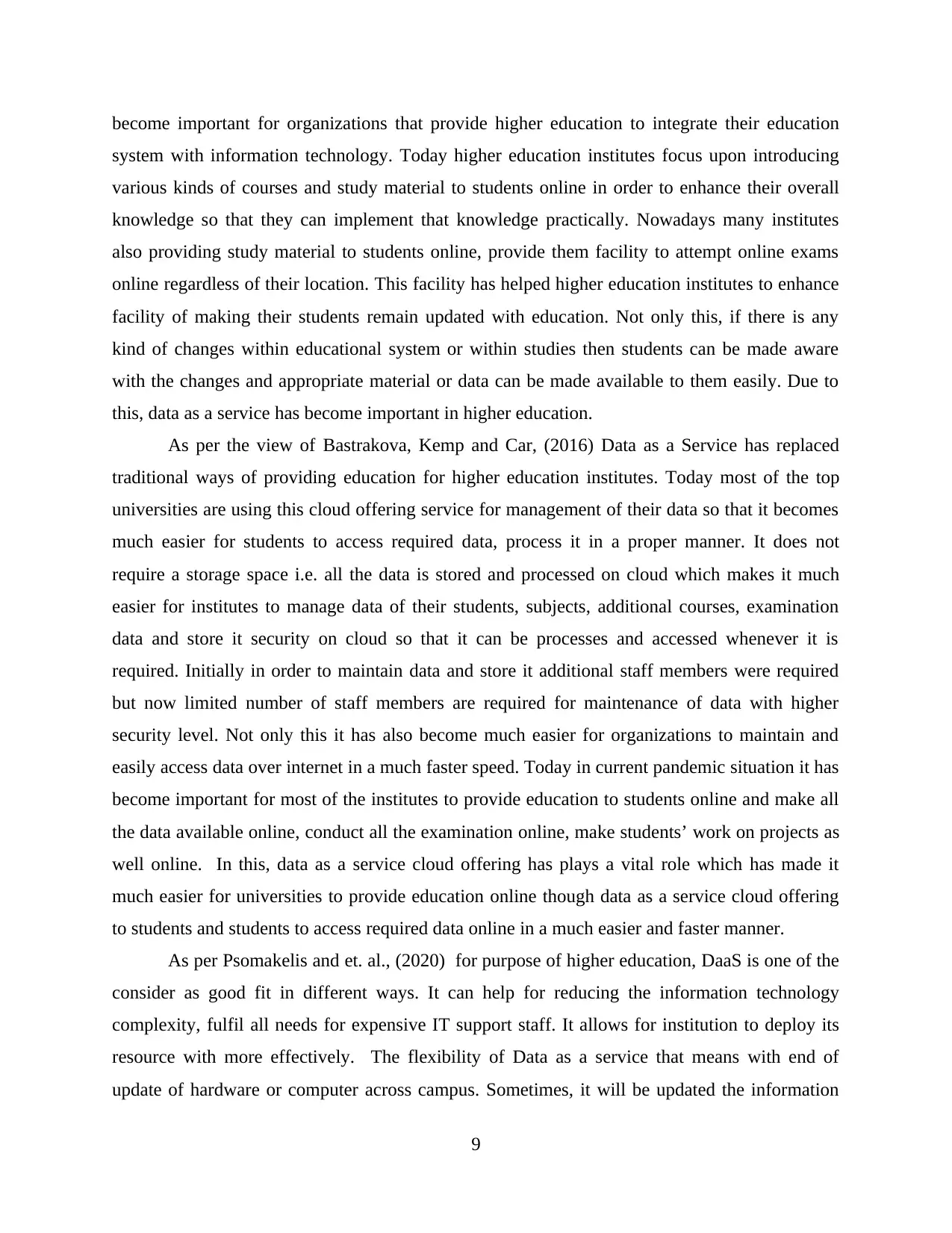
become important for organizations that provide higher education to integrate their education
system with information technology. Today higher education institutes focus upon introducing
various kinds of courses and study material to students online in order to enhance their overall
knowledge so that they can implement that knowledge practically. Nowadays many institutes
also providing study material to students online, provide them facility to attempt online exams
online regardless of their location. This facility has helped higher education institutes to enhance
facility of making their students remain updated with education. Not only this, if there is any
kind of changes within educational system or within studies then students can be made aware
with the changes and appropriate material or data can be made available to them easily. Due to
this, data as a service has become important in higher education.
As per the view of Bastrakova, Kemp and Car, (2016) Data as a Service has replaced
traditional ways of providing education for higher education institutes. Today most of the top
universities are using this cloud offering service for management of their data so that it becomes
much easier for students to access required data, process it in a proper manner. It does not
require a storage space i.e. all the data is stored and processed on cloud which makes it much
easier for institutes to manage data of their students, subjects, additional courses, examination
data and store it security on cloud so that it can be processes and accessed whenever it is
required. Initially in order to maintain data and store it additional staff members were required
but now limited number of staff members are required for maintenance of data with higher
security level. Not only this it has also become much easier for organizations to maintain and
easily access data over internet in a much faster speed. Today in current pandemic situation it has
become important for most of the institutes to provide education to students online and make all
the data available online, conduct all the examination online, make students’ work on projects as
well online. In this, data as a service cloud offering has plays a vital role which has made it
much easier for universities to provide education online though data as a service cloud offering
to students and students to access required data online in a much easier and faster manner.
As per Psomakelis and et. al., (2020) for purpose of higher education, DaaS is one of the
consider as good fit in different ways. It can help for reducing the information technology
complexity, fulfil all needs for expensive IT support staff. It allows for institution to deploy its
resource with more effectively. The flexibility of Data as a service that means with end of
update of hardware or computer across campus. Sometimes, it will be updated the information
9
system with information technology. Today higher education institutes focus upon introducing
various kinds of courses and study material to students online in order to enhance their overall
knowledge so that they can implement that knowledge practically. Nowadays many institutes
also providing study material to students online, provide them facility to attempt online exams
online regardless of their location. This facility has helped higher education institutes to enhance
facility of making their students remain updated with education. Not only this, if there is any
kind of changes within educational system or within studies then students can be made aware
with the changes and appropriate material or data can be made available to them easily. Due to
this, data as a service has become important in higher education.
As per the view of Bastrakova, Kemp and Car, (2016) Data as a Service has replaced
traditional ways of providing education for higher education institutes. Today most of the top
universities are using this cloud offering service for management of their data so that it becomes
much easier for students to access required data, process it in a proper manner. It does not
require a storage space i.e. all the data is stored and processed on cloud which makes it much
easier for institutes to manage data of their students, subjects, additional courses, examination
data and store it security on cloud so that it can be processes and accessed whenever it is
required. Initially in order to maintain data and store it additional staff members were required
but now limited number of staff members are required for maintenance of data with higher
security level. Not only this it has also become much easier for organizations to maintain and
easily access data over internet in a much faster speed. Today in current pandemic situation it has
become important for most of the institutes to provide education to students online and make all
the data available online, conduct all the examination online, make students’ work on projects as
well online. In this, data as a service cloud offering has plays a vital role which has made it
much easier for universities to provide education online though data as a service cloud offering
to students and students to access required data online in a much easier and faster manner.
As per Psomakelis and et. al., (2020) for purpose of higher education, DaaS is one of the
consider as good fit in different ways. It can help for reducing the information technology
complexity, fulfil all needs for expensive IT support staff. It allows for institution to deploy its
resource with more effectively. The flexibility of Data as a service that means with end of
update of hardware or computer across campus. Sometimes, it will be updated the information
9
⊘ This is a preview!⊘
Do you want full access?
Subscribe today to unlock all pages.

Trusted by 1+ million students worldwide
1 out of 46
Related Documents
Your All-in-One AI-Powered Toolkit for Academic Success.
+13062052269
info@desklib.com
Available 24*7 on WhatsApp / Email
![[object Object]](/_next/static/media/star-bottom.7253800d.svg)
Unlock your academic potential
Copyright © 2020–2025 A2Z Services. All Rights Reserved. Developed and managed by ZUCOL.




